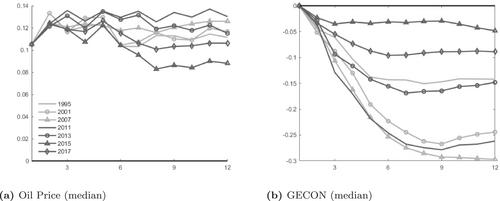The shale oil boom and the US economy: Spillovers and time-varying effects
IF 2.3
3区 经济学
Q2 ECONOMICS
引用次数: 0
Abstract
We provide new evidence that the transmission of oil price shocks to the US economy has changed with the shale oil boom. To show this, we develop a time-varying parameter factor-augmented vector autoregressive (FAVAR) model with a large data environment of state-level, industry, and aggregate US data. The model effectively captures potential spillovers between oil and non-oil industries, as well as variation over time. Specified in this way, we find that investment, income, industrial production, and (non-oil) employment in most oil-producing and some manufacturing-intensive US states increase following an oil-specific shock—effects that were not present before the shale oil boom.

页岩油繁荣与美国经济:溢出效应和时变效应
我们提供的新证据表明,随着页岩油的繁荣,油价冲击对美国经济的传导发生了变化。为了证明这一点,我们开发了一个时变参数因子增强向量自回归(FAVAR)模型,并使用了由州级、行业和美国总体数据组成的大型数据环境。该模型有效地捕捉了石油和非石油产业之间的潜在溢出效应以及随时间的变化。通过这种方法,我们发现在页岩油繁荣之前,美国大多数产油州和一些制造业密集型州的投资、收入、工业生产和(非石油)就业在石油特定冲击效应之后都出现了增长。
本文章由计算机程序翻译,如有差异,请以英文原文为准。
求助全文
约1分钟内获得全文
求助全文
来源期刊

Journal of Applied Econometrics
Multiple-
CiteScore
3.70
自引率
4.80%
发文量
63
期刊介绍:
The Journal of Applied Econometrics is an international journal published bi-monthly, plus 1 additional issue (total 7 issues). It aims to publish articles of high quality dealing with the application of existing as well as new econometric techniques to a wide variety of problems in economics and related subjects, covering topics in measurement, estimation, testing, forecasting, and policy analysis. The emphasis is on the careful and rigorous application of econometric techniques and the appropriate interpretation of the results. The economic content of the articles is stressed. A special feature of the Journal is its emphasis on the replicability of results by other researchers. To achieve this aim, authors are expected to make available a complete set of the data used as well as any specialised computer programs employed through a readily accessible medium, preferably in a machine-readable form. The use of microcomputers in applied research and transferability of data is emphasised. The Journal also features occasional sections of short papers re-evaluating previously published papers. The intention of the Journal of Applied Econometrics is to provide an outlet for innovative, quantitative research in economics which cuts across areas of specialisation, involves transferable techniques, and is easily replicable by other researchers. Contributions that introduce statistical methods that are applicable to a variety of economic problems are actively encouraged. The Journal also aims to publish review and survey articles that make recent developments in the field of theoretical and applied econometrics more readily accessible to applied economists in general.
 求助内容:
求助内容: 应助结果提醒方式:
应助结果提醒方式:


